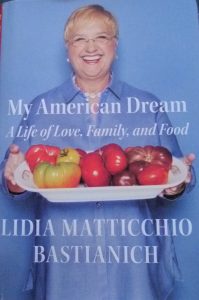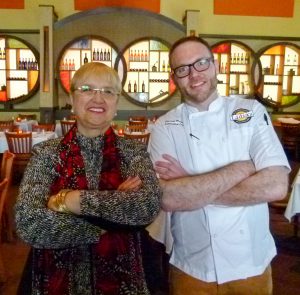Lidia Bastianich’s ‘My American Dream’ A Compelling Read

Are you looking for a good read? One that has an escape from a communist country, romance, American entrepreneurial success, and farm-to-table Italian cooking in it? Then Lidia Mattichio Bastianich’s My American Dream: A Life of Love, Family, and Food is just the book for you.
Bastianich is the award-winning chef/owner of the restaurants Felidia, Lidia’s Pittsburgh, Lidia’s Kansas City, and several Eataly locations; author of 16 books, and star of several PBS cooking shows including her latest, “Lidia’s Kitchen.” My American Dream is her latest book and a personal memoir. In it, Bastianich recalls in amazing detail the journey of her life.
Early life in Pula
She was born in Pola, Istria, on February 21, 1947. It was then part of Italy, but a post-war settlement agreement in September of that same year gave ownership of the territory to the communist country, Yugoslavia (Istria is now part of Croatia). The Istrian peninsula had a large Italian population, many of whom fled to Italy at that time. Bastianich and her family continued living there for nine years under the Marshal Tito regime. They lead a somewhat comfortable life there. Her mother, Erminia, was a school teacher and her father, Vittorio, had a small trucking business.
Under Tito the name of the town was changed from Pola to the Slavic Pula, The family also had their name changed by the government from Matticchio to Motika. At one point the government took one of Vittorio’s two trucks saying he only needed one truck in a communist land.
Bastianich, her mother and father, and brother Franco lived in an apartment in Pula. Some of her favorite memories of living in Istria were visiting her beloved grandmother, Nonna Rossa, in the nearby country town of Busoler. Rossa had a small farmstead (so small the communist government didn’t bother to confiscate it). It was from these visits to Nonna Rossa’s that Bastianich first was exposed to farm-to-table cooking. She learned to respect what you ate and not to waste anything. This is especially evident when she recounts the snout-to-tail utilization of a slaughtered pig. Bastianich said a group of women would work to clean the pig’s stomach and intestines with vinegar and water to prepare it for tripe and sausage casings. In the book she gives keen insights into the rural farm life of the day.
Escape from Communism
In 1956, growing tired of life in a communist dictatorship, the family executed their escape plan. Erminia took Lidia and Franco by train to Trieste, Italy under the guise of visiting a very ill relative. Vittorio had to stay behind as one member of a family traveling outside the country had to remain behind to ensure the return of the others. Vittorio had his own escape plan, albeit a most difficult one. The family soon reunited in Trieste and lived with a relative before they were sent to live at the city’s refugee camp, San Sabba. They would live there for two years.
As the family grew more trusted in the camp they were allowed to spend their days outside the camp. Under the good graces of an Italian family Bastianich was enrolled in La Scuola Canossiana, a Catholic school. The nuns who taught there took a liking to her and she started helping the nuns make their lunches. This was another exposure to cooking and food preparation for Bastianich at an early age. Both her knowledge of cooking and her Catholicism deepened during this period and would continue to intertwine throughout her life.
As a refugee in the camp Bastianich got her first taste of American staples. Peanut butter, sliced white bread, and American cheese were sent to the camp from the United States for the refugees.
Coming to America
After two years the family was finally able to emigrate to their country of choice, America. Catholic Relief Services helped bring Bastianich and her family to the United States, settling them in the New York City area. The family worked hard to overcome the language barrier and forge new relationships in this foreign land. There was somewhat of a learning curve, especially in the supermarket. Erminia accidently bought, ate, and served dog cookies, thinking they were for people.
The family moved to Queens. Bastianich studied hard at Astoria’s William Cullen Bryant High School, and also took some home economics courses. With her mother commuting a long distance to get to a factory job, it was up to Bastianich, under her mother’s direction, to get dinner ready for the family after her school day. She developed a fascination with boxed cake mixes and their ease of making with just adding eggs and a few other ingredients. At the age of 15, Bastianich got her first real job, working as a counter person at Walken’s Bakery. After a while she did some cake finishing work there.
At 16 Lidia met her future husband, Felice Bastianich, who was seven years her senior, a restaurant captain, talented accordionist, and Istrian native. They would marry when she was only 18. Lidia enrolled at Hunter College and contemplated becoming a doctor. She also worked at several Italian-American restaurants in Manhattan, thus gaining more exposure to the restaurant industry.
She and Felice decided to open their own restaurant. In 1971, they opened a small restaurant, Buonavia, in the Forest Hills neighborhood of Queens. They hired a good chef and Lidia worked as the hostess, always being very welcoming to the patrons. After taking a break to look after the couple’s two young children, Joseph and Tanya, Lidia returned and assisted in the kitchen, further honing her skills, and even adding some Istrian dishes to the menu after sensing that the time was right.
The success of Buonavia led to opening a bigger restaurant, Villa Secondo, also in Queens. Having two successful restaurants put Lidia firmly on the radar of the restaurant industry and press as a rising-star chef and restaurant owner.
The family made several trips to Italy each year, discovering the foods and wines of various regions and arranging suppliers. Sometimes, in order to try several outstanding restaurants, they would have two restaurant lunches or dinners in a single day. This was often to the chagrin of Joseph and Tanya, who would protest and remain in the rental car where they would engage in carbonated San Pellegrino bottled water spraying fights.
Felidia
The siren song of Manhattan was calling out to Felice and Lidia to open a restaurant there. Having a restaurant in Manhattan comes with its own prestige and pressures. The couple went all-in to achieve that dream, selling both of the Queens restaurants after finding a suitable location for their new venture in Manhattan. Even with that it still was going to be very tight financially.This was a very stressful time for Lidia, Felice, and the family. An undetected major building-foundation problem delayed the opening of their new restaurant, Felidia, and put the entire venture in great peril. With help from family, friends, and even a few competitors Felidia opened and had great success. In addition to her cooking prowess, Lidia knows the power of publicity, public relations, and marketing and has used those skills to great effect over her career.
As Lidia grew more famous, Felice felt somewhat left out. He also yearned for his previous life in Istria. These and other reasons caused the couple to divorce. They did remain friendly and shared some family events together. Felice would die in 2010. After the divorce, Lidia felt a little more free to pursue her interests.

The namesake of Lidia’s Pittsburgh, Lidia Bastianich, and executive chef, Daniel Walker.
After striking up a friendship with cooking show pioneer Julia Child, she was invited to be a guest on Child’s TV show “The French Chef.” This sowed the seeds for Bastianich’s long cooking-show run on PBS, which began in 1998 and continues with her latest show, “Lidia’s Kitchen.” She credits daughter Tanya Bastianich Manuali as an integral part of her enterprises. Manuali has co-authored several books with her mother, and is owner and executive producer of Tavola Productions, which produces “Lidia’s Kitchen.” She is also a managing partner in several of the family’s restaurants including Lidia’s Pittsburgh and Lidia’s Kansas City. Son Joseph owns several restaurants with Lidia including Babbo, Del Posto, Esca, Becco, and several Eatalys. He also looks after the Bastianich wine interests, and is a judge and mentor on FOX TV’s “MasterChef.” Lidia’s mother, Erminia, continues to offer her love, support, and wisdom to the family.
Spirituality and Hospitality
Bastianich had an informal book launch reception for My American Dream with the local dining media at Lidia’s Pittsburgh. It was my third time talking with her and she is always extremely nice and gracious. Her spirituality and hospitality are expressed both through her personal warmth and her cooking and entertaining for people. She likes to make people feel happy and welcome with her cooking, whether it’s a bunch of Joe’s college friends when he would bring them home from Boston College or in preparing meals for Popes Benedict XVI and Francis. Lidia’s life has come full circle and with several grandchildren, she is now the beloved nonna to them as Nonna Rossa was to her.
My American Dream is a fascinating story of overcoming obstacles through personal perseverance and the help of family and friends to become a highly successful and respected American. The book is published by Knopf and can be purchased through retail and online booksellers, at Lidia’s Pittsburgh restaurant, or on Lidia Bastianich’s website.
Rick Handler is the executive producer of Entertainment Central.
Share on Social Media
Follow Entertainment Central
Latest Stories
Sign up for the EC Newsletter







